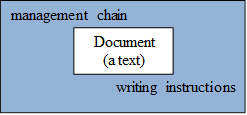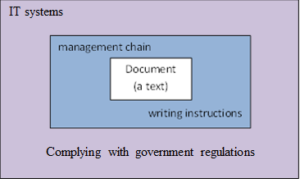By Dana P Skopal, PhD
Organisations produce many documents and this creation of documents can be a complex process. We use this abstract noun ‘process’ in different ways, just like the word ‘purpose’. This abstraction and complexity may be why often a writer may not be able to produce the document that management are looking for.
Additionally, a document’s ‘problem’ may not sit with its writer but where that document sits within an organisation’s document hierarchy. Some may ask, ‘so what’? However, understanding where a document sits within the business or government system is important. A document is not written in a vacuum; our research has shown that the communication processes surrounding the directives to write a document can affect its content.
We have previously talked about understanding a document’s purpose as being the key to writing a clear text. However, a document’s purpose can be set through an organisation’s processes that link to why the document is required.
Let’s examine this through a diagram. Think about the document being in the middle, which shows that factors outside the document actually impact on it (based on Fairclough, 1992). The first factors are the communication processes within the organisation and these mould the role of the document. These processes (the blue area) include the position of the document in the organisation’s document hierarchy as well as the writing instructions given to staff.
Next, these processes are encircled within industries’ requirements (eg ISO standards) or government regulations (eg compliance) that impact on the organisation. These requirements and regulations link to systems (the purple area) that an organisation needs to have in place, which can range from IT systems to management systems.
These broad organisational processes and systems usually have different requirements to that which an individual writer may be used to, which can impact on their approach to writing. For example, an engineer may list the technical elements in a board paper, but the board and directors are looking for a clear recommendation with a rationale linked back to those technical elements.
Organisations need to inform staff of a document’s purpose as that knowledge assists when writing. The purpose links to the organisational processes, which include where that document sits in relation to other documents in that organisation and those going to stakeholders. These organisational processes also include any writing instructions, such as in a template, so in fact, the writing does not occur in isolation.
Perhaps these processes should be viewed as communication processes: has management clearly conveyed to the writer what is important and how the information in the document may be used?
Overall, the communication processes can be viewed as the interactions between the individuals associated with that organisation. Therefore, there are many communicative steps that occur prior to producing a final written document and that can impact on its usability (Skopal & Herke, 2017; Cheng & Mok, 2008; Halliday & Hasan, 1989). This is why management in organisations need to slow down to make sure that staff understand why they are writing the document.
References
Cheng, W., & Mok, E. (2008). Discourse processes and products: Land surveyors in Hong Kong. English for Specific Purposes, 27, 57-73.
Fairclough, N. L. (1992). Discourse and social change. Cambridge: Polity Press.
Halliday, M. A. K., & Hasan, R. (1989). Language, Context and Text: aspects of language in a social-semiotic perspective. Oxford: Oxford University Press.
Skopal, D. P. & Herke, M. (2017). Public discourse syndrome: reformulating for clarity. Text & Talk, 37 (1), pp. 141–164. doi: 10.1515/text-2016-0041


